
The Britannic Organ, Vol. 11: Historic Improvisations by British & German Organists features recordings of improvisations made on the Welte Philharmonie Organ in the Museum for Musical Automations in Seewen.
Bottle Post Secrets presents seventeen-year-old organist Sebastian Heindl, a former member of the Leipzig Thomanerchor, playing his new transcription of Paul Dukas’s ballet, La Péri, in honor of Dukas’s 150th birthday anniversary. In this transcription, Heindl displays the ways in which three of Dukas’s students—Jehan Alain, Oliver Messiaen, and Maurice Duruflé—interpreted and developed further their master’s understanding of music.
Widor: Organ Symphonies Vol. 5, the fifth in Signum’s sequence of the organ symphonies of Charles-Marie Widor, features Joseph Nolan on the Cavaillé-Coll organs of La Madeleine, Paris, and Saint-Sernin, Toulouse.
For information: www.naxos.com.



